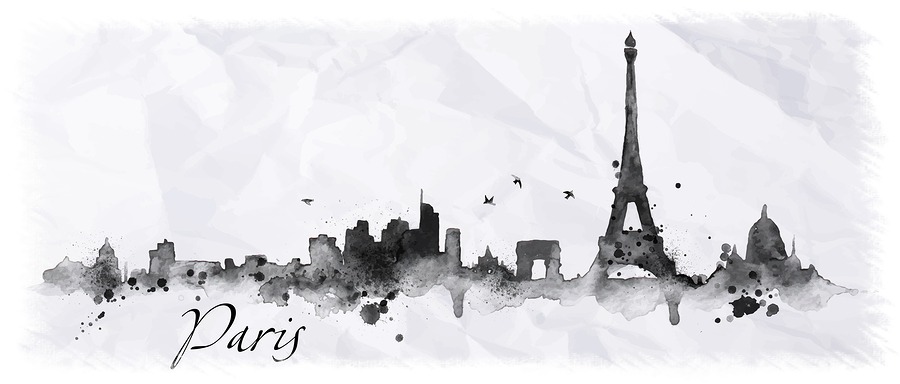
The recent terror attacks in Paris have drawn attention to the changing face of world relationships. It is a reminder of the traumatic events that occurred in America on September 11th and its aftermath. The violence in Paris and the hotel bombing in Mali trigger thoughts, memories, and feelings about those attacks for people who experienced the September 11th attacks either personally or vicariously. As news of the attacks on France spread, memories of expressions of sympathy, including those from France, also came to mind and continue to be returned as they were given.
Violence has been part of human relationships from the beginnings of recorded history. From murder of a brother to mass killings, the Bible provided an historical account that supplement other historical recordings of mankind’s inhumane behavior towards each other. Accounts of human violence and ideological wars are confirmation not that history repeats itself but that human behavior appears to have change little throughout history. While technology has altered the details, humans continue to harm each other through waging wars, taking by force, and attempting to extinguish cultures, ideologies, and entire ethnic groups. However, humans exhibit admirable characteristics, and pro social accomplishments often seem to go unrecognized or are quickly overshadowed by more sensational news. Human beings possess the capacity to bounce back after adversity, a characteristic called resilience. Violence and terror are not uniquely American, or European, or Middle Eastern, or Asian. It is a human thing, a reflection of the dark side of the human heart but not necessarily the spirit.
What Constitutes Societal Violence?
The World Health Organization (WHO), as cited in Privitera, Bowie, & Bowen (2015), defined violence as more than physical force or even the threat of physical force with the intent or likelihood to cause harm or death to self or others. WHO also expanded the scope of violence to include actions resulting in psychological ham, or that prevent healthy development, or the withholding of the basic necessities of life. While acts of violence generate reactions of varying degrees of intensity, intentional acts of violence are usually more difficult to accept than those that appear to be unintentional (Privitera et al). Verbal accounts from clients who have experienced traumatic events indicate they have more difficulty making sense of what happened to them and finding a higher purpose or meaning for their pain and loss when the traumatic event involved the intentional and willful perpetration of harm by another human being. Simply, it is difficult to understand how one human being can perpetrate harm on another. Such intentional willful violence, often reported in national and world news, also tend to defy a singular explanation as noted by Pilch and Turska (2015). Instead, the public is left grappling for some viable reason based on little more than a hypothesis about a series of complex interactions involving multiple factors.
The need to know how and why something happened is related to the human desire for homeostasis, especially as it relates to survival seeking behaviors. The limbic system is an area of the brain sometimes referenced as the mammalian brain. It is comprised of several structures that receive and store information via the five senses to activate survival behaviors of flight, fight, and freeze. Higher ordered reasoning in not a function of the limbic system but memory storage to activate pain and pleasure cascades is. When violence or trauma is experienced, the limbic than encodes the correlated sensations and stimuli as unpleasant a dangerous. When element of that memory are activated by something that seems similar, the limbic system reacts to protect the individual. This is commonly referred to as a trigger.
There are other models that seek to explain violence, among them is the ecological model (Krug, Dahlberg, Mercy, Zwi, & Lozano, R. Eds., as cited in Wadsworth, 2013) described in a study about workplace violence . Irrespective of which model one utilizes to understand the underpinnings of violet acts and whether they occur in the home, in the neighborhood, in schools, in the workplace (employees, customers, suppliers), in religious institutions, or in governments, or whether the aggression is widespread or confined to a small area on few victims, the common factor is human beings. The encouraging aspect is that the common resolution is also human beings. Franklin D. Roosevelt’s well-known statement, “The buck stops here,” comes to mind, and this is the mantra required of every individual who desires to participate in the creation of safer world with each person in society collectively implementing a plan of personal accountability and assertive behavior.
Violence presents with many faces, some contained, some planned, some impulsive, and some massive and sophisticated. Uncontained violence such as large scale riots, acts of terrorism, mass shootings were rarely reported in the media prior to 9/11. They are now a part of public awareness and occurring often enough to give rise to companies who provide educational service and products related to workplace and corporate safety. The world has changed, and the message and approach seems to be that survival depends on the ability to adapt to a world where mass violence is an accepted part of life.
After 9/11 acts of jihad or holy war triggered strong negative reactions with little thought of their similarities to other historical acts of war claiming religious or ideological principles. When it comes down to it, is there anything happening today that has not already been conceived and acted on at some point in time? The trappings differ but the nature of the problem is pretty much the same. As long as people remain self-absorbed and egocentric, there is little likelihood of peaceful coexistence. Rather than aggressive attitudes and behaviors characteristic of people today, whether jihad, mass shooting, or serial violence, no single factor fully explains the motivation and mind set of people who promote aggression and violence (Pilch & Turska, 2015). Humans can, and often do, rationalize thoughts and behaviors they normally would find objectionable if it serves their needs. The differing factor today versus 100 years ago involves the sophistication of means to carry out violence or surveil other people and nations. However, just because the technology exists to create new tools and products, it is no indicator the human race is disciplined enough or sophisticated enough to warrant its use.
Contributing Factors:
Another source of anger and frustration associated with violence is the sense of powerlessness, which is prevalent throughout society. Citizens perceive they have little or no influence over government decisions that affect their lives, their families, and their livelihoods. They are witnessing their Constitutional rights being given away, legislated away, and usurped or pressured out from under them. People are feeling frustrated when laws are blatantly disregarded, even in the presence of those sworn to uphold the law, leaving residents feeling unprotected and unsafe in their neighborhoods and homes. Children are feeling unsafe and stressed at school; they report they are anxious of violating zero tolerance policies, afraid to honor their religious beliefs because of overly zealous rules and policies, anxious of not performing well enough to please parents or gain admiring to college. Parents are stressed feeling the need to protect their children in a world greatly different from their childhood world. They are reluctant to parent stating they fear they will he charged with child abuser for disciplining their children. Companies are saddled with greater regulations that eat into profits and result in their needing to function with fewer employees while maintaining productivity requirements. This means employees are working longer hours while realizing diminished compensation after adjusting for inflation and rising costs. Is it any wonder people are feeling overwhelmed, disillusioned, frustrated, stressed, ineffective, and angry? Galtung (as cited in Privitera, 2014) believed violence is correlated with unmet needs. There is much talk in the media about the importance of psychological needs as well as physical and survival needs. If unmet psychological needs influence mental health, what effect might unmet psychological needs play in acts of violence?
As pressure continues to build and the problems of providing for needs goes unresolved, the hope of better times ahead dissipates. It is as if we are living in a social pressure cooker with a defective safety valve, and people are succumbing to the heat and pressure in the pot – sometimes via interpersonal violence, sometimes through health problems, sometimes through mental health problems, and sometimes through behavior based on radical beliefs foreign to the world of those whose beliefs differ. When violence is added to the pot, these conditions contribute to the development of trauma sequel are by draining resiliency factors.
References
Ayunerak, P., Alstrom, D., Moses, C., Charlie, J., & Rasmus, S. M. (Sep 2014). Yup'ik culture and context in southwest Alaska: Community member perspectives of tradition, social change, and prevention. American Journal of Community Psychology, 54, 91-99. doi:10.1007/s10464-014-9652-4.
Chaudhary, N. & Chadha, N. K. (2014). Time for a change: Appling Gandhian perspective for a fulfilling and contented life. Indian Journal of Positive Psychology, 5(2), 155-159. http://www.iahrw.com/index.php/home/journal_detail/19#list
Pilch, I. & Turska, E. (2015). Relationships between Machiavellianism, organizational culture, and workplace bullying: Emotional abuse from the target’s and the perpetrator’s perspective. Journal of Business Ethics, 128, 83-93. doi:10.1007/s10551-014-2081-.
Privitera, M. R., Bowie, V., & Bowen, B. (2015). Translational models of workplace violence in health care. Violence and Victims, 30(2), 293-307.
Wadsworth, S. M. (2013). Understanding and supporting the resilience of a new generation of combat-exposed military families and their children. Clinical Child Family Psychology Review, 16, 415-420. doi:10.1007/s10567-013-0155-x.
About the Author
 Karen J. Allen, MS, LMHC
Karen J. Allen, MS, LMHCKaren invests her time and energies towards helping people overcome the effects of painful situations and events. She works extensively with people using various therapeutic skills such as Eye Movement Desensitization and Reprocessing therapy, Accelerated Resolution Therapy, clinical hypnosis, Rapid Resolution Therapy, Cognitive Behavioral Therapy, and other trauma focused interventions including traumatic grief.
Office Location:
716 S. Oakwood Ave.
Brandon, Florida
33511
United States
Phone: 813-373-0315
Contact Karen J. Allen
Karen J. Allen has a clinical practice in Brandon, FL
Professional Website:
www.karen-allen-lmhc.com